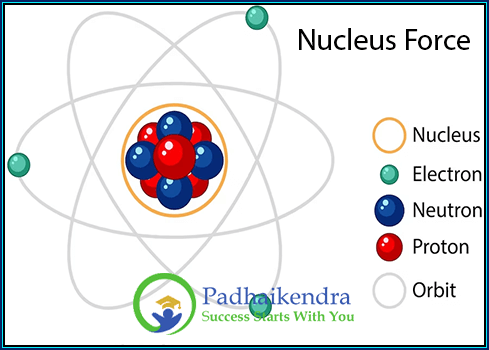Force inside the nucleus
Inside the tiny world of the atomic nucleus, there are powerful forces at work. These forces hold the nucleus together and control how its particles behave. They are like invisible hands that shape the nucleus’s structure. By studying these forces, we can begin to understand the amazing world that exists deep within atoms. Let’s take a closer look at the forces inside the nucleus and discover the wonders they reveal-
Strong Nuclear Force
The strong nuclear force, also known as the strong interaction or strong force, is the most powerful force operating within the nucleus. It is responsible for holding the positively charged protons and neutral neutrons together, overcoming the electrostatic repulsion between protons. The strong force is extremely short-range, acting only over distances of about 10^-15 meters (femtometers). It binds nucleons (protons and neutrons) together to form atomic nuclei and is approximately 100 times stronger than the electromagnetic force.
The nuclear force is responsible for the stability of the nucleus and plays a crucial role in nuclear reactions. Without the nuclear force, protons would repel each other and the nucleus would disintegrate. However, the nuclear force is also responsible for the radioactivity of some isotopes, as it can sometimes cause nucleons to be ejected from the nucleus in a process called nuclear decay.
Electromagnetic Force (Electrostatic Force)
 The electromagnetic force is responsible for the interaction between charged particles, such as protons and electrons. While it is weaker than the strong nuclear force, it still plays a significant role in determining the stability and properties of atomic nuclei. The electromagnetic force is responsible for holding the negatively charged electrons in their respective orbits around the nucleus, maintaining the overall charge neutrality of the atom.
The electromagnetic force is responsible for the interaction between charged particles, such as protons and electrons. While it is weaker than the strong nuclear force, it still plays a significant role in determining the stability and properties of atomic nuclei. The electromagnetic force is responsible for holding the negatively charged electrons in their respective orbits around the nucleus, maintaining the overall charge neutrality of the atom.
Weak Nuclear Force
The weak nuclear force, also known as the weak interaction or weak force, is responsible for certain nuclear processes, such as radioactive decay and neutrino interactions. It is involved in processes that change the identity or flavor of particles, such as beta decay, where a neutron in the nucleus transforms into a proton, emitting an electron (beta particle) and an antineutrino. The weak force is considerably weaker than the strong and electromagnetic forces.
Gravitational Force
The gravitational force is the weakest of all fundamental forces but still plays a role in the dynamics of large-scale systems, including celestial bodies. Although its influence within the atomic nucleus is negligible compared to the other forces, it becomes significant when considering interactions between massive objects.
The electrostatic force and the nuclear force are the two main forces that operate inside the nucleus, and they work together to determine the properties and behavior of atomic nuclei.
These fundamental forces collectively govern the behavior of particles inside the atomic nucleus, determining the stability of nuclei, the processes of nuclear reactions, and the overall structure of matter at the subatomic level. The interplay between these forces gives rise to the rich and complex phenomena observed in nuclear physics.





